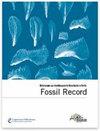下载PDF
{"title":"德国开姆尼茨二叠纪石化森林中最年轻的三角tarbus schuberti n. gen., n. sp.","authors":"Jason A. Dunlop, Ronny Rößler","doi":"10.1002/mmng.201300012","DOIUrl":null,"url":null,"abstract":"<p>A new trigonotarbid (Arachnida: Trigonotarbida) is described as <i>Permotarbus schuberti</i> n. gen., n. sp. from the Early Permian Petrified Forest (Rotliegend) of Chemnitz in Saxony (Germany). At ca. 290 Ma it represents the youngest record of this extinct arachnid order discovered to date. Its familial affinities are uncertain, but may lie close to the Aphantomartidae. The distribution of the trigonotarbid genera through time is summarised, together with a list of their seventy-seven fossil-yielding localities. Together they offer a broad overview of the group's fossil record, which is heavily biased towards the Moscovian Stage (ca. 307–312 Ma) of the Late Carboniferous in Europe and North America. This is due in no small part to numerous localities associated with coal mining districts, and trigonotarbids are found less frequently after this stage. While it is tempting to associate this with biological events – such as a putative ‘Carboniferous Rainforest Collapse' dating to ca. 305 Ma – it is difficult to differentiate the effects of genuine extinction patterns from artefacts caused by fewer appropriate localities in the economically less relevant latest Carboniferous and Early Permian strata. Nevertheless, trigonotarbids became extinct at some point after the Early Permian and loss of the Coal Measures forests remains one of the most likely possible causes. (© 2013 WILEY-VCH Verlag GmbH & Co. KGaA, Weinheim)</p>","PeriodicalId":55147,"journal":{"name":"Fossil Record","volume":"16 2","pages":"229-243"},"PeriodicalIF":1.4000,"publicationDate":"2013-08-05","publicationTypes":"Journal Article","fieldsOfStudy":null,"isOpenAccess":false,"openAccessPdf":"https://sci-hub-pdf.com/10.1002/mmng.201300012","citationCount":"16","resultStr":"{\"title\":\"The youngest trigonotarbid Permotarbus schuberti n. gen., n. sp. from the Permian Petrified Forest of Chemnitz in Germany\",\"authors\":\"Jason A. Dunlop, Ronny Rößler\",\"doi\":\"10.1002/mmng.201300012\",\"DOIUrl\":null,\"url\":null,\"abstract\":\"<p>A new trigonotarbid (Arachnida: Trigonotarbida) is described as <i>Permotarbus schuberti</i> n. gen., n. sp. from the Early Permian Petrified Forest (Rotliegend) of Chemnitz in Saxony (Germany). At ca. 290 Ma it represents the youngest record of this extinct arachnid order discovered to date. Its familial affinities are uncertain, but may lie close to the Aphantomartidae. The distribution of the trigonotarbid genera through time is summarised, together with a list of their seventy-seven fossil-yielding localities. Together they offer a broad overview of the group's fossil record, which is heavily biased towards the Moscovian Stage (ca. 307–312 Ma) of the Late Carboniferous in Europe and North America. This is due in no small part to numerous localities associated with coal mining districts, and trigonotarbids are found less frequently after this stage. While it is tempting to associate this with biological events – such as a putative ‘Carboniferous Rainforest Collapse' dating to ca. 305 Ma – it is difficult to differentiate the effects of genuine extinction patterns from artefacts caused by fewer appropriate localities in the economically less relevant latest Carboniferous and Early Permian strata. Nevertheless, trigonotarbids became extinct at some point after the Early Permian and loss of the Coal Measures forests remains one of the most likely possible causes. (© 2013 WILEY-VCH Verlag GmbH & Co. KGaA, Weinheim)</p>\",\"PeriodicalId\":55147,\"journal\":{\"name\":\"Fossil Record\",\"volume\":\"16 2\",\"pages\":\"229-243\"},\"PeriodicalIF\":1.4000,\"publicationDate\":\"2013-08-05\",\"publicationTypes\":\"Journal Article\",\"fieldsOfStudy\":null,\"isOpenAccess\":false,\"openAccessPdf\":\"https://sci-hub-pdf.com/10.1002/mmng.201300012\",\"citationCount\":\"16\",\"resultStr\":null,\"platform\":\"Semanticscholar\",\"paperid\":null,\"PeriodicalName\":\"Fossil Record\",\"FirstCategoryId\":\"89\",\"ListUrlMain\":\"https://onlinelibrary.wiley.com/doi/10.1002/mmng.201300012\",\"RegionNum\":4,\"RegionCategory\":\"地球科学\",\"ArticlePicture\":[],\"TitleCN\":null,\"AbstractTextCN\":null,\"PMCID\":null,\"EPubDate\":\"\",\"PubModel\":\"\",\"JCR\":\"Q3\",\"JCRName\":\"Earth and Planetary Sciences\",\"Score\":null,\"Total\":0}","platform":"Semanticscholar","paperid":null,"PeriodicalName":"Fossil Record","FirstCategoryId":"89","ListUrlMain":"https://onlinelibrary.wiley.com/doi/10.1002/mmng.201300012","RegionNum":4,"RegionCategory":"地球科学","ArticlePicture":[],"TitleCN":null,"AbstractTextCN":null,"PMCID":null,"EPubDate":"","PubModel":"","JCR":"Q3","JCRName":"Earth and Planetary Sciences","Score":null,"Total":0}
引用次数: 16
引用
批量引用


